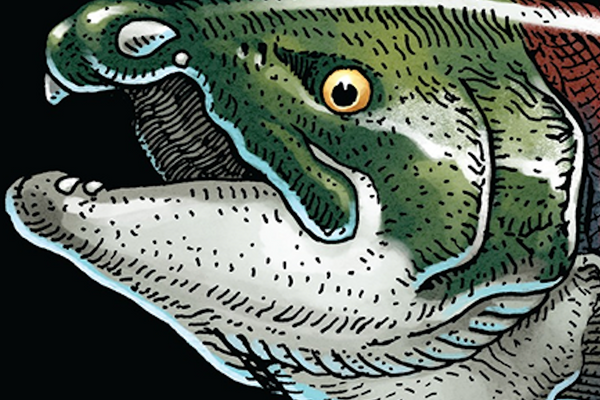Why Scientists Snorkled Behind Bumphead Parrotfish in Pursuit of Their Poop
To learn whether these giant, goofy fish are good or bad for beleaguered coral reefs.

Stalking bumphead parrotfish for science is a bit of a mixed bag. On one hand, it involves hours of snorkeling in the crystalline waters around the Palmyra Atoll, several dozen islets freckling the Pacific Ocean between Hawaii and American Samoa. The water is turquoise and rich with coral—all the better for the hungry parrotfish, who eat it—and the land is lush, managed by the U.S. Fish and Wildlife Service as a refuge for red-footed boobies and bristle-thighed curlews.
On the other hand, the fish are huge—Bolbometopon muricatum can reach up to 4.5 feet long, and 165 pounds or so—and fairly funky-looking. Their foreheads are almost comically bulbous, like they’ve just been clonked on the head. Their mouths, with 1,000 strong, sharp teeth that demolish coral, algae, and squishy polyps, make them look like perpetually startled horses. And then there’s the reason scientists were in the water to begin with: to collect their prodigious amounts of poop.

These fish are grazers, and like grazers on land, their dietary habits have an wide-ranging impact on their ecosystem. Each bumphead parrotfish consumes up to 5.69 tons of reef material annually, ranging from live corals to coral pavement, rubble, and other chunks. Nearly everything that goes in one end comes out the other. So any given bumphead parrotfish expels about 4.8 tons of feces a year—and some of that material washes ashore, where blissfully unaware beachgoers bury their toes in it. The distinctive white sands along the Caribbean Sea and ringing islands in the South Pacific? It doesn’t come from years of erosion, but from the workings of a parrotfish’s pharyngeal mill, which crushes calcium carbonate coral skeletons like a rock grinder.
“It’s this plume that spreads out larger than their body size, and a lot settles,” says Grace Goldberg, a member of the McClintock Lab at the Marine Science Institute at the University of California, Santa Barbara. A single hefty individual fish can expel 1,000 pounds of sand each year, according to the Smithsonian Institution, and the University of Hawaiʻi has estimated that as much of 70 percent of the pretty stuff on those white-sand shores was once in a parrotfish’s gut.

This is just one of the many ways that coral reefs are connected to other ecosystems, but reefs are complicated, fragile places that are under increasing duress—from bleaching, garbage, fishing, and acidifying oceans. That’s why a team of marine scientists led by Goldberg took a closer look at the parrotfish’s ecosystem-shaping feces. How does it hurt or benefit a reef, or change the the water around it?
“What we were curious about is, wouldn’t it be cool if, because these fish are grinding up calcium carbonate and putting sand dust into the water, it kind of protected the reef from acidification locally, and allowed corals and other calcifying organisms to continue going about its life?” Goldberg says. At the same time they were also interested in whether the waste is rich in nitrogen and phosphorus, and could potentially function as a kind of fertilizer, especially for the algae and other plants that could overrun reefs and outcompete coral for nutrients and light.

To determine the nutrient makeup of parrotfish poop, and how a dusting of it impacts the pH of the ecosystem, the team first had to collect it. As they describe in a recent paper in the journal Coral Reefs, that involved kicking toward “the densest portion of the cloud of feces,” and collecting a mix of feces, fresh sand, and seawater in a glass bottle. For comparison, they gathered normal seawater samples nearby. They also sucked up fresh excrement samples in a syringe.
When they got the samples back to the lab, they showed … not a whole lot, at least as far as nitrogen and phosphorus are concerned. The samples contained very little of either. And the water samples didn’t show a significant difference in pH, either. The authors concluded that there was “no evidence that excreted calcium carbonate has a significant buffering effect on localized areas.”

With their craving for coral, it might be tempting to cast bumphead parrotfish as potential threats to at-risk reefs—but that would be too simple. In the reef environment—and many other ones—any given species can do both harm and good. Even though bumphead parrotfish do seem to have a particular hankering for live corals, Goldberg doesn’t view them as a problem: Despite basically eating coral all the time, evolution has shaped a multifaceted role for parrotfish. Previous research, published in Conservation Biology, showed that while bumpheads, whose own ranks have dwindled, do decrease coral colony size and abundance, they also open up space for new coral settlement and helped control the algae that can monopolize light and sustenance. In that way, they’re a little like the goats that park staff might enlist to oust invasive species. Except goats don’t keep us up to our ankles in warm, gleaming beach sand.





















Follow us on Twitter to get the latest on the world's hidden wonders.
Like us on Facebook to get the latest on the world's hidden wonders.
Follow us on Twitter Like us on Facebook